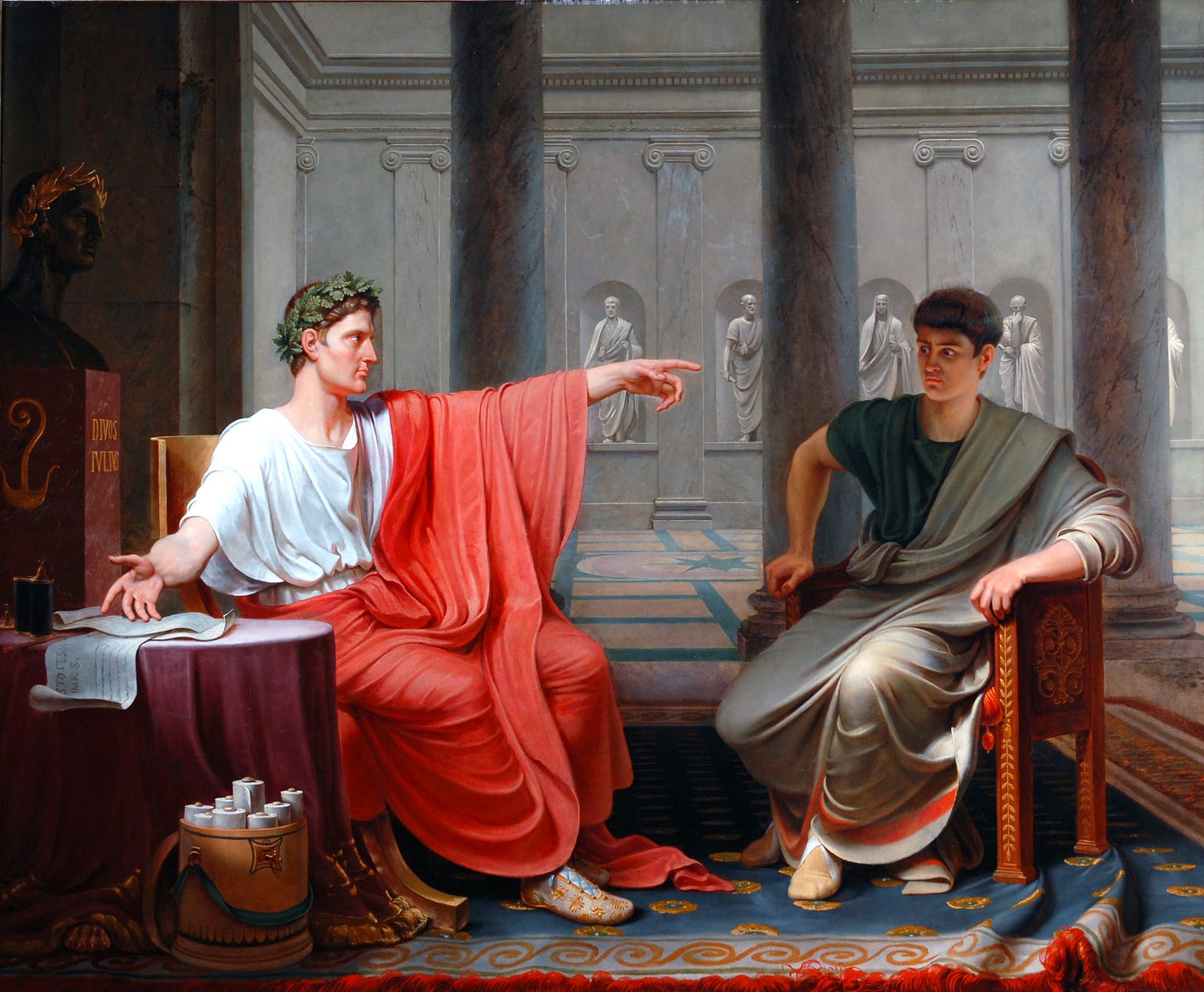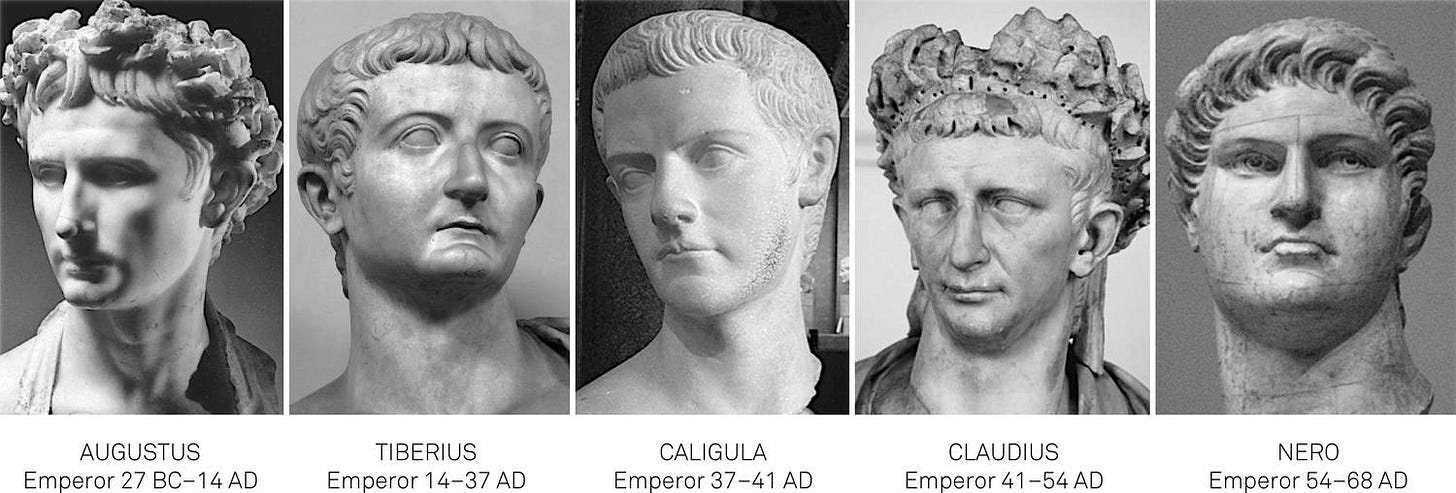The Julio-Claudian dynasty was the very first family to rule the Roman Empire. It consisted of Rome’s first five emperors: Augustus, Tiberius, Caligula, Claudius, and Nero. The regime lasted from 27 BC until Nero’s suicide in 68 AD, ending the dynasty in disgrace.
The name of the dynasty comes from two prominent Roman families, the Julius and Claudius families.
Augustus
Rome’s first emperor was Augustus Caesar. Lacking any male heirs, Octavian married off his only child, his daughter Julia, to his loyal friend Marcus Agrippa. Their marriage produced five children: Gaius, Lucius, Julia the Younger, Agrippina the Elder, and Agrippa Postumus.
Gaius and Lucius, the first two kids of Julia and Agrippa, were adopted by Augustus as his heirs. Augustus favored the two children of his wife Livia. These were Tiberius and Drusus. Both were successful military leaders who had fought valiantly against the barbarian German tribes.
When Agrippa died in 12 BC, Emperor Augustus ordered Tiberius to divorce his wife Vipsania Agrippina, the daughter of Agrippa by his first marriage, and to marry his stepsister, the twice-widowed Julia. Drusus, Tiberius’ brother, died after falling from a horse in 9 BC.
Tiberius shared in Augustus’ tribune powers, but he soon after went into voluntary exile at Rhodes in 6 BC. After the unexpected deaths of Lucius and Gaius, in 2 and 4 AD respectively, the exile of both Julias for adultery, the dynasty was left in shambles. Augustus was forced to recognize Tiberius as his legitimate successor. By Augustus’ request, Tiberius adopted his nephew Germanicus.
Tiberius
Augustus died on August 19, 14 AD—in the month that bears his name. By this time, Tiberius had become the Princeps in all but name, and his position as heir was confirmed by Augustus’ will.
Despite a strenuous relationship with the Senate, Tiberius’ first years were generally good. Following Augustus’ orders, he favored Germancius over his natural son, Drusus, for Rome’s imperial throne. The Roman populace agreed.
After the beloved Germanicus died in battle while campaigning in Germania, Tiberius began to outsource the day-to-day running of the Roman Empire to a man named Sejanus. Sejanus fomented an atmosphere of fear in Rome, controlling a vast network of spies and informers, who accused others of treason as a pretext to steal their property. Treason trials became common. The Roman aristocracy was no longer sage.
Tiberius grew increasingly paranoid, and he imposed a reign of terror. According to the historian Suetonius, the emperor led a cruel and depraved life at his villa on the island of Capri, where he forced underage boys and girls into perverted orgies. When one unfortunate boy complained, the wicked Tiberius ordered his legs be broken as punishment.
If Augustus had been an enlightened despot, Tiberius took tyranny to a whole new level, setting the tenor for the rest of the ill-reputed Julio-Claudian dynasty.
Caligula
In keeping with Augustus’ plans, Tiberius appointed his successor as Gaius Julius Caesar Augustus Germanicus, a man better known by his childhood nickname Caligula. The new emperor was the great-grandson of Augustus.
When Tiberius died on March 16, 37 AD, Caligula assumed the throne with relative ease. He continued the tradition of tyranny, and several assassination attempts were made on his life. Finally, the Praetorian Guard, backed by the Senate, killed their unhinged emperor on January 21, 41 AD. Caligula was stabbed by his assassins while he was going to a theater.
Claudius
After getting rid of the corrupt Caligula, the Senate made another vain attempt to restore the Republic. Claudius, the paternal uncle of Caligula, was chosen as the new emperor by the Praetorian Guard.
Despite his lack of political experience, and the disapproval of the Roman people, Claudius managed to be an adept ruler. He initiated numerous building projects.
Under his reign, the Roman Empire expanded, invading Britain in 43. Unlike his more corrupt predecessors, Claudius was a rather benign ruler. He took a personal interest in the law, and presided at public trials. He was seen as vulnerable and easy to manipulate, especially by Rome’s nobility.
However, Claudius was far from popular, and survived several assassination attempts. To gain political support, he married Agrippina and adopted his great-nephew Nero. He died on October 13, 54 AD, possibly being poisoned by Agrippina.
Nero
Rome’s first imperial dynasty came to a disgusting, bitter end with the reign of Nero. The 16-year-old Nero became Rome’s emperor in 54 AD. Like Caligula, he was a direct descendent of Augustus. This made it easier for him to assume the throne without much challenge.
He seized power, banishing rivals and undermining the Senate. He arranged the death of his own mother, as well as his ex-wife. After the Great Fire of 64, the emperor enacted new public relief efforts and reconstruction projects, funded by heavy taxation on Rome’s provinces.
The Senate grew angry with Nero’s usurpation, and led the Pisonian conspiracy, led by a man named Piso, to overthrow him. Around 68, Vindex, the governor of Gaul, revolted against Nero’s tax policies. To gain support, Vindex called upon Galba, the governor of Spain, to become the new emperor.
As Galba marched into Rome, Nero committed suicide. The Julio-Claudian dynasty was no more. But who would become the new rulers of Rome? That question would be resolved by the chaotic Year of the Four Emperors, in 69 AD.






